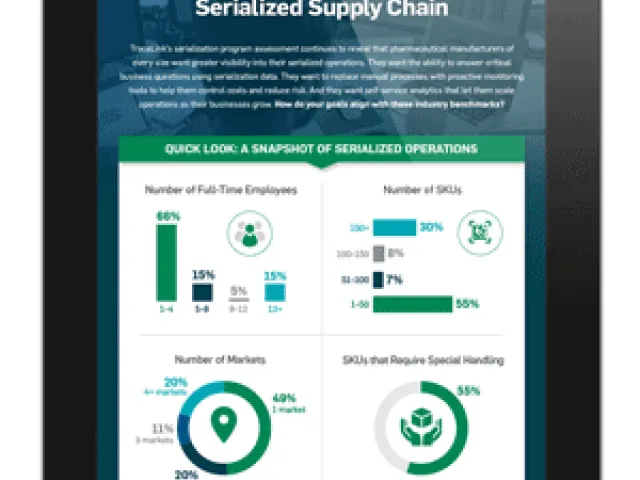Table of contents
What is Total Cost of Ownership?
Many life sciences companies approaching serialization, regardless of their size, will rank price as one of their top decision criteria. But when it comes to developing an accurate serialization budget, many create their forecast without a thorough breakdown of all costs they’ll incur throughout the serialization life cycle.
The total cost of ownership (TCO) is a financial estimate of the direct and indirect costs to help companies calculate their total investment over the life of a product or system. If you are in the midst of solution selection now, it’s important to ask questions to avoid the risk of having your long-term serialization costs soar. As you conduct your research, ask each third-party vendor that you are considering to prepare a TCO for you. Devise your own checklist of questions, or take along the one provided for you by clicking the Download TCO Checklist button.
Acquisition is Just the Tip of the Iceberg
Acquisition cost is the stated price for a provider’s platform or service, and it typically includes a software license or subscription fee. It may leave out all the other costs of meeting compliance requirements though, including implementing, maintaining, and upgrading all your systems and technical infrastructure. One of your main goals, then, will be to identify all the underlying costs of the entire serialization iceberg.
Breaking Down the Whole Iceberg
Depending on your serialization requirements and company size, your TCO can be 10 times or more than your initial acquisition cost. In order to plan, build, and deploy your project, you’ll encounter the direct or “hard” costs, which are the upfront expenses. In addition, you’ll have ongoing costs that will develop over time. Finally, you’ll need to consider the solution-specific costs, such as plug-ins and compliance modules offered by different vendors. In other words, you should be looking at the entire iceberg to discover what costs go beyond just what’s on the surface.
To truly take all related costs into account, consider these key cost factors in your TCO planning:
Software license or subscription fees
What the provider charges for their software. They may occur as a one-time fee, or as recurring monthly or annual fees. Fees may cover a range of users, or require individual licenses for each user. You may also encounter additional database and application server fees.
Serial number and variable transaction fees
What you are charged to generate, store, and interact with serial numbers and the events aligned with those serial numbers. With an average of four to seven events per serial number, along with your estimated volume growth, be sure you are prepared to handle additional drug products or manufacturing customers if necessary.
Hardware and infrastructure
The cost of adding additional hardware and infrastructure to support on-site or private service for data storage, processing, and access. Your information processing requirements will be 15,000 times more and the size of the serialization database will be 5,500 times larger for the same volume of products you ship today. Consider, too, that you will need database and application server licenses just to run your serialization solution, with additional costs for replicating in dedicated development, QA, and production environments, plus a separate high-performing environment for security, redundancy, and disaster recovery.
Storage
What you’ll pay for the long-term storage and access needed to meet regulatory data-retention requirements. Your infrastructure must be able to support trillions of objects — and terabytes of data — generated by serialization each year, and this massive volume must be stored and searchable for an extended period of time. There are often government data retention requirements for up to 12 years. Being able to rapidly interact with all this serialized data to support critical supply chain events such as verification inquiries and target recalls saves staff time and reduces risk to your company’s drug product supply.
Integration with customers and trade partners
The cost of connecting with each trading partner in order to achieve information and exchange data with them. In order to exchange required regulatory data represents one of the biggest serialization costs in terms of both time and expense. Setting up dozens to hundreds of point-to-point connections will bring considerable expense to your project: at the minimum, it takes 10 days and costs $15,000 per connection, with the average CMO integration taking between 30-45 days. In addition, each time a trade partner or government makes a change in their requirements, you will need to make costly updates to each one.
Customization
Additional configuration costs are driven by manual rewriting when your solution lacks pre-built, out-of-the-box integrations. Rather than off-the-shelf functionality, some solutions require the use of a toolkit that requires you to build your business logic in order to support data verification and customized workflows.
Integration with internal business systems
The cost of configuring, testing, and deploying your serialization software to integrate with internal packaging lines, ERP and warehouse systems, and master data. Evaluate whether the solutions you are considering have pre-built, out-of-the-box integrations with your core business systems.
Master data
Functions as a single source of truth to build a reliable system of record for serialization and track and trace. Inconsistencies in your master data can cost you in terms of labor and system resources. Be sure to address the cost of master data management from project inception in order to evaluate its impact on developing more efficient business processes and ensuring compliance. Otherwise, even small inconsistencies in your master data can cost you even more in terms of labor and system resources.
Validation
The associated costs of validating integrations with your serialization solution provider, including all installation qualification (IQ) and operational qualification
Training
Provides access to instructors, learning programs, and support materials to enable your company’s success. Training costs include product-specific educational materials and instruction for your staff and system administrators. Take into account the availability of virtual and live instructor-led training sessions, webinars, e-learning courses, student guide modules, and quick reference materials, and the pricing models for each. Training costs occur both at the time of initial deployment and also when you hire new staff, or when there are significant software or industry updates. A solution that offers the same training to the entire user community — as well as to your trade partners — will not have to pass customized training expenses on to individual customers.
Support
Allows you to gain
IT personnel
What it will cost to provide the necessary in-house staff in terms of training, availability, and technical skills, your outsourcing demands, and availability. IT costs can be significant, depending on how much you will need to support onsite infrastructure, regulatory compliance issues, and corresponding business systems. How many qualified, full-time staff will you need to support implementation and upgrades? Based on specialized skill set needs, will you need to hire additional team members, or supplement with consultants? If so, your costs can quickly grow as you address the technical needs of serialization. CMOs that work with new brand customers may also need to ramp up or outsource their IT resources to accommodate the additional workload.
Upgrade costs
The costs you will incur when upgrading your solution to meet new compliance requirements, as well as growth opportunities. These arise every time country or trade partner requirements change, and you need to update your solution. Specific costs include the staff required to perform upgrades and patches for operating systems and security, hardware expansion costs to support volume growth, and the labor required for decommissioning legacy systems when they become obsolete and require replacement. Rewriting integrations can also impact your internal system software, resulting in additional staff time to upgrade other dependent applications.
Downtime
The direct and indirect costs associated with systems that are down for maintenance and other operational events. Downtime interruptions not only cost a lot of money in terms of time and labor, they also potentially halt the movement of your company’s drug product through the supply chain. Estimate the cost of taking systems offline to perform planned system implementation, maintenance, upgrades, decommissioning, and performance testing, and keep in mind the additional expense and risk of unplanned emergency downtime and outages.
This is a long list of potential direct and indirect serialization costs, but it’s still not comprehensive. A proven solution provider will be able to help identify additional costs you should expect to encounter based on your company’s requirements and their implementation experience. Will you need to hire consultants? Outsource your IT needs? Update and validate other dependent systems? The list — and the total cost of ownership — can grow very large, very quickly. As a result, it can be difficult to estimate your TCO on your own.
Technology Models and their Impact on Your TCO
As you consider different serialization solution vendors, ask each one to complete a total cost of ownership for you. Understand, though, that the technology model they use will have a significant impact on their pricing, and the list of items that aren't included
Single-Tenant
A single-tenant environment is essentially virtualization in your own data center. You will have to purchase your own hardware, securing enough capacity for peak times and paying for the performance delta that rarely gets used. Connectivity to each of your customers and trade partners will need to be established and maintained through individual point-to-point connections. In addition, significant internal resources will be required to perform implementation, plus testing, training, software updates, and other ongoing tasks.
The TraceLink Life Sciences Cloud
The TraceLink Life Sciences Cloud uses a native cloud-computing, network-tenant architecture to address many of the costs of serialization within an all-inclusive subscription model, eliminating separate line items and unpredictable costs.
As part of your fixed cost, network-tenancy enables you to leverage more than 230,000 trade partners already connected to the TraceLink network. This ability to connect once and interoperate with everyone on the network eliminates the need to establish and maintain point-to-point connections, regardless of how many trade partners you have now or may need to add in the future. TraceLink partners with Amazon Web Services (AWS), which allows us to operate on a utility model; since we only pay for the hardware and resources we use, we are able to pass lower costs along to our customers. And unlike single-tenancy, network-tenancy on the cloud means that the cost of maintaining an internal staff to manage hardware, implementation, and ongoing maintenance is eliminated.
Regardless of project size, side-by-side comparisons show that TraceLink consistently delivers a significantly lower TCO than other single-tenant or on-premises alternatives.










